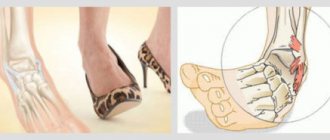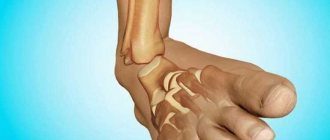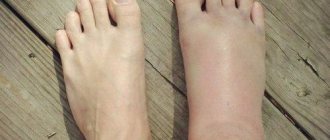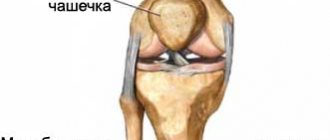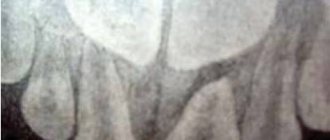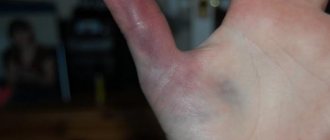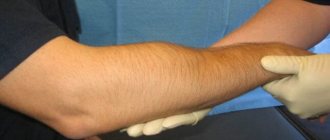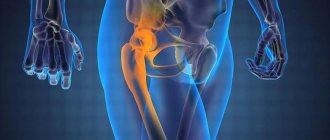Dislocation is a displacement of the joint surfaces and damage to the joint capsule. As a rule, this injury is accompanied by acute pain, due to which the victim is unable to make any movements with the injured limb. Dislocation is different in that although the bones are in the wrong position, their integrity is not compromised.
The human leg contains many joints, so it is quite vulnerable. In most cases, the knee joint or foot is damaged. But regardless of the type of injury, the victim must undergo treatment in a hospital setting.
Foot dislocation
The foot area accounts for approximately 2% of all dislocation cases. This includes damage to the talus and metatarsal bones, fingers, and ankle joints. Due to the anatomical features of this part of the limb, dislocations do not occur as often as fractures. It takes significant external force to cause such an injury.
Under no circumstances should you try to straighten your foot yourself! The only thing that can be done is to provide first aid to the victim and take him to the hospital for an accurate diagnosis.
Preventive recommendations
Prevention of this kind of damage is extremely simple: you need to take care of your feet. People involved in active sports should be especially careful - during training, the risk of dislocations becomes very high. Before each workout, you should definitely warm up. Additionally, you need to work on increasing strength, elasticity and muscle tone. Stretching exercises help a lot.
Girls are strongly advised to give up uncomfortable shoes and too high heels - all this puts a lot of strain on their feet. And it’s extremely easy to trip on huge stiletto heels. Control your gait and periodically give your legs a rest.
You need to carefully choose shoes for children. It should have a high back and ensure that the foot is fixed in the correct position.
Take care of yourself and be healthy!
Knee dislocation
When the knee joint is injured, the tibia and femur bones move in relation to each other. Under normal conditions, these bones are connected by ligaments, but if the latter are damaged, dislocation occurs. Although this happens rarely, mainly as a result of serious damage - for example, in a car accident, a fall from a significant height, etc.
A sprained knee looks unnatural; the limb is curved rather than straight. Less commonly, when a dislocation resolves spontaneously, the damaged area swells and the person suffers excruciating knee pain.
Characteristic
An injury that involves the displacement of bones in the joints that make up the foot and also in the ankle area is called a sprained ankle. Widespread damage is recorded at all ages, but more often in people from 22 to 49 years old, which is associated with an active lifestyle.
In children, dislocation is a rare occurrence, this is explained by the high elasticity of the ligaments. In old age, people move carefully, which is an excellent prevention of injury.
In most cases, the ankle joint is affected. The discrepancy is observed in the articulation between the fibula, tibia and talus. There are several options for injury:
- External dislocation - when the foot is turned in with support on its inner part and a trajectory in the lateral direction. In most cases, the injury is accompanied by a fracture of the lateral malleolus.
- Internal - if the foot goes inward, and the load is transferred to the outer edge of the foot. With this type of injury, the anatomical integrity of the medial (inner) malleolus is disrupted.
- Posterior leg sprain – Diagnosed when the foot rolls backward with weight being transferred to the top side of the foot. Appears after a strong blow to the bones of the lower leg in front.
- Anterior - pathological discrepancy is recorded when there is a blow to the rear, more often when landing unsuccessfully on the heel from a great height.
In traumatological practice, the first two types are more common than the anterior and posterior directions. In addition, the phalanges of the fingers may become dislocated during forced bending or when walking barefoot on an uneven surface.
Other types of sprains on the leg:
- talus;
- subtalar dislocation;
- tarsal bones (in Chopart's joint);
- metatarsal bones (Lisfranc joint involved).
Each type has its own characteristics in manifestations, severity, as well as treatment and duration of the recovery period.
How to determine a dislocation
So, there is a suspicion of a dislocation. What to do in this case? First of all, you need to make sure that it is really a dislocation. And for this, in turn, it is necessary to know the symptoms at least in general terms.
On a note! It must be remembered that the human leg includes 30 bones that are connected to each other. This means that if the little finger is dislocated, this is also considered a dislocated leg.
The symptoms of a sprain are not at all similar to those of a sprain or bruise. Yes, often the damaged area actually swells instantly, and the swelling quickly increases, but at this time the joint is in an unnatural position, springs, and its normal functioning is impossible (the victim cannot not only actively move, but also make passive displacements in the event of external influence) .
We also note that a dislocated finger very often manifests itself in the same way as a fracture. Similarity in terms of symptoms is not always good, but you need to remember that after an injury - be it a fracture or a dislocation - a person should be provided with first aid, and then taken to the hospital as soon as possible.
On a note! If the dislocation is not serious, then few people go to the doctor, but in vain. The fact is that in case of injury, not only ligaments, but also blood vessels can be damaged. There are many reasons why people do not go to the hospital: some believe that the injury is trivial and soon everything will “go away on its own”, others do not want to sit in lines, and still others do not want to have an x-ray.
You need to remember: it’s better to spend a little time than to let the dislocation progress to a point where more serious consequences may appear. Moreover, an x-ray is prescribed only in the most serious cases, since doctors often determine the nature of the damage through visual and manual examination.
Characteristic manifestations
The problem under consideration is characterized by all the manifestations noted with any kind of dislocation: deformation, painful effects, swelling, limited mobility. More detailed information on this matter is covered in the table.
Table. Symptoms of a sprained ankle
| Symptoms | Description |
| Pain | Occurs immediately at the moment of injury. Accompanied by sounds similar to crunching. Then the pain subsides against the background of a decrease in the sensitivity of the corresponding receptors due to their overexcitation, after which it arises with renewed vigor and causes suffering to the patient when making the slightest movements of the damaged part of the body. |
| Edema | They intensify over time, spreading around the circumference. May differ in immediate appearance. In such situations, they manifest themselves as bluish skin, as well as hematomas. |
| Deformations | The nature of their severity is determined by the type of dislocation obtained and the intensity of displacement of the injured foot. For example, in the case of subluxations, there are no visually noticeable deformities. With a complete dislocation, the damaged foot may remain in a bent state. |
| Mobility restrictions | The patient cannot walk or put weight on the affected leg. Complete dislocation makes even the slightest passive movements impossible. |
What to do if your leg is sprained?
If you suspect a dislocation, the main thing is not to attempt to straighten the joint yourself. This should only be done by a qualified doctor, and today this often involves the use of local anesthetics and muscle relaxants. It is not difficult to identify an injury yourself - this can be done using the symptoms described above.
There is no need to check the mobility of the injured joint by flexion/extension with your hands - it is enough for the victim to try to do this himself. And if, for example, there were suspicions of a dislocated finger, but the person could move it (the finger), then the diagnosis was erroneous. But swelling and pain are still a serious reason to go to the nearest trauma center.
First aid for a sprained leg involves taking a few simple steps.
- First you need to fix the damaged joint, for which you can use a piece of board or something similar that has a flat surface. If the knee joint is injured, the leg should be placed on this flat surface and tied under and above the knee. If we are talking about a dislocated toe, then you just need to immobilize the foot using a small object (for example, you can tie a regular cutting board to the plantar surface).
- After providing first aid, the victim must visit the hospital (either independently or with assistance). There the doctor will examine him, take an x-ray if necessary, diagnose the injury and provide qualified medical care.
On a note! If first aid is not provided in time, then serious difficulties may arise during further treatment.
First aid to the victim
It is impossible to leave a dislocation unattended and try to cure it on your own - this will only worsen the situation. The maximum permissible amateur activity is first aid to an injured person.
Important! The names of all medications are provided for informational purposes only. Specific drugs and the order of their use are determined by the doctor.
First, the leg must be left alone and secured in an elevated position, for example, by placing a rolled-up blanket under it. This will help reduce swelling.
Secondly, cold must be applied to the damaged area. Better - an ice pack. Otherwise, even frozen meat or a cold can of drink will do. Cold is applied for no more than 15 minutes at a time.
Thirdly, it is necessary to ensure correct fixation of the joint.
Attention: it is prohibited to set it in the absence of appropriate medical skills. For fixation, the joint is wrapped with an elastic bandage. Don't wrap it too tightly - you risk cutting off blood circulation. To avoid this, control your skin color.
What to do after treatment
As for treatment for dislocation, it consists of three stages.
Stage 1.
Reduction.
Stage 2.
Immobilization of the reduced joint, which eliminates stress. Immobilizers or regular tires are often used for fixation.
Stage 3.
In some cases, after eliminating the swelling, surgical intervention is required, because if the ligament is dislocated, it can be seriously damaged.
During the healing period (often it lasts about three weeks), it is necessary to maintain bed rest, and high activity and physical exertion should also be avoided. A repeat image of the joint is taken to ensure that all the bones are in place. Along with immobilization, anti-inflammatory and analgesic drugs (Dolaren, Analgin) are often prescribed, which eliminate pain and normalize the condition of damaged tissues. In some cases, chondroprotectors are prescribed to stimulate the restoration of cartilage tissue.
After immobilization, when the bandage is removed, it is necessary to regularly engage in physical therapy and go to special massage sessions.
Physical therapy may also be prescribed to help speed up healing.
As for traditional methods of treatment, they are not applicable to a dislocated leg, since they do not give any effect (as well as external preparations and ointments during the period of immobilization). The only way folk remedies will help is to relieve swelling and pain. But they are used only as an addition to the main course of treatment.
Table. Folk remedies for pain relief and swelling during dislocation
| Name | Description, recipe |
| Immediately after an injury, crushed leaves of this plant can be applied to the joint to reduce pain. | |
| You can use a special ointment to rub or massage a sprain. It is prepared as follows: a teaspoon of grated bryonia root is mixed with sunflower oil (about 100 ml) and placed in a boiling water bath for a couple of hours. Next, the mixture is filtered and rubbed into the injured joint (or, alternatively, near the applied plaster cast). | |
| A compress prepared in this way can be applied to a joint that has already been set: a teaspoon of bryonia root is poured into 500 ml of hot water and boiled for 15 minutes. The mixture is then cooled and strained. A linen napkin is moistened in the prepared decoction and applied to the damaged area (if the bandage has not yet been applied) or above/below it (if the dislocation is already immobilized). | |
| To eliminate inflammatory processes progressing inside the joint capsule, in parallel with other remedies, it is recommended to use the decoction described below. Take comfrey root, lingonberry leaves, bean pods and arnica flower baskets in a ratio of 1:1:1:1, all this is crushed and thoroughly mixed. Next, the mixture is poured with water (at the rate of 500 ml per tablespoon of the mixture) and cooked in a water bath for five minutes. Then the mixture sits for half an hour and is filtered. The finished infusion should be drunk ½ glass before each meal. | |
| Compresses made from a decoction of crops such as calendula, burdock, yarrow, tansy, etc. are also quite effective. |
Finally, we note once again that when a lower limb is dislocated, the main thing is to provide first aid in a timely manner and take the person to the hospital as soon as possible. Otherwise, serious complications may occur (for example, with advanced dislocation, osteomyelitis, bursitis and even arthrosis may occur).
Clinical picture
A sprained leg is accompanied by symptoms that are characteristic of this type of injury. At the time of injury, a dull click is heard in the foot area, which is replaced by severe pain. The pain persists, and when you try to move the injured leg, it becomes more intense.
The occurrence of pain is influenced by irritation of nerve endings, and if larger nerves are damaged, neurological symptoms occur. Loss of tactile sensitivity, burning, tingling on the skin periodically appear when the innervation of the foot is disrupted. Severe injuries can lead to paralysis - complete immobilization below the site of injury.
The key manifestation of a dislocation is deformation of the damaged joint. Often the heads of bones located outside the joint capsule are clearly visible under the skin. The unnatural shape of the joint is accompanied by a pathological deviation of the foot in the direction of the trajectory of the impact, which led to injury.
Due to edema, the leg swells, increasing in size compared to a healthy leg. Increasing swelling in the soft tissues increases the pain, which is bursting in nature. Numerous bruises appear in the area of displaced bones. When the deep layers of the skin are damaged, hematomas appear for several days, adding “fresh” bruises to the passing manifestations of subcutaneous hemorrhage.
In addition, when the anatomical location of the articular bones is disturbed, blood vessels are often compressed. A decrease in microcirculation is manifested by pale skin, and in severe cases, blue discoloration. The foot is cold, and there is a decrease in body temperature on the injured foot. A common cause of complete cessation of blood supply is a dislocation in the Chopart joint. This condition can be complicated by gangrene and result in amputation of the foot.
Diagnostics
A traumatologist makes a diagnosis and chooses a treatment method. Determining the nature of the injury on your own, much less making a decision on therapeutic action, is useless at best. Complications may not appear immediately, but sometimes delay can lead to disability.
The diagnostic examination consists of examination, physical and hardware examination. During the medical history, the doctor finds out the cause of the injury and complaints. A preliminary diagnosis is made based on external signs and, if necessary, neurological and pain tests.
An objective assessment is made based on the results of radiography and MRI. Research helps not only determine the type and severity of a dislocation, but also promptly suspect the presence of concomitant injuries to ligaments, bones, and tendons.
reduction of the joint
realignment of the joint
Dislocation is considered a serious, dangerous injury that must be treated exclusively in a medical facility. Independent action in resolving this issue is excluded. The most common method of restoration is to realign the joint, after which it returns to its normal position. The specialist must take the time to eliminate concomitant symptoms, in particular hemorthrosis. To do this, a puncture is made, cold compresses or a splint are applied.
In the most serious cases, the patient may require surgery, followed by a long rehabilitation process, accompanied by the supervision of the attending physician. Surgery is prescribed only in case of complete rupture of tendons or ligaments. The modern equipment that Dr. Glazkov’s clinic has allows us to consider the surgical intervention minimally invasive, so the recovery period is also minimal.
Prevention
Adequate nutrition and regular exercise make the muscles strong and the ligaments elastic. Compliance with the principles of a healthy lifestyle is one of the points of injury prevention. In addition, you can prevent a sprained leg by being careful when moving and avoiding extreme sports. For daily wear, it is recommended to buy comfortable shoes, in winter - with anti-slip elements on the soles. If an injury occurs, be sure to consult a doctor within the first hours after the incident.
Rehabilitation
After wearing a rigid splint for a long time, muscle and connective tissue needs to be restored. Rehabilitation measures include:
- Massage sessions are conducted in courses. The manipulation is carried out by a specialist who has a therapeutic massage technique.
- Wearing a bandage for the ankle joint: at first, a semi-rigid orthosis with flexible metal inserts is prescribed, subsequently a compression bandage of light fixation is used.
- A dislocated leg provokes a violation of the biomechanics of the foot and the development of flat feet. Therefore, orthopedic insoles are placed in shoes to reduce the load and support the arches in the correct position.
- Therapeutic gymnastics plays one of the leading roles in restoring movement to the sore leg. Exercises are selected by a doctor and performed regularly. Over time, the complex is adjusted. It includes more complex exercises and gradually increases the load.
With early diagnosis, compliance with all doctor’s instructions, compliance with the recommended regime of activity and rest, in 95% of cases the injury ends in recovery.
